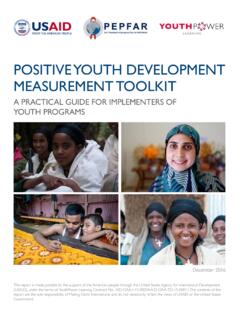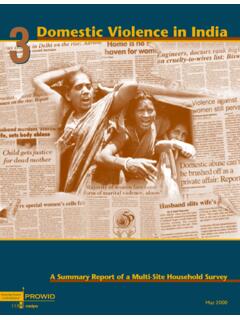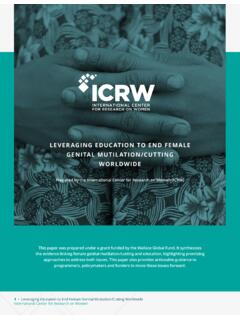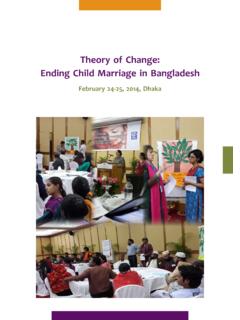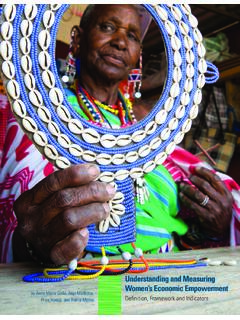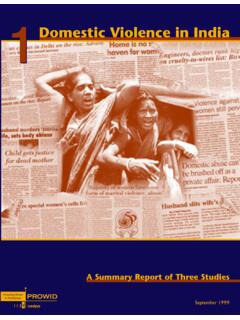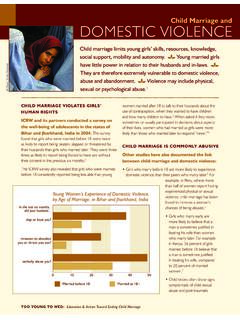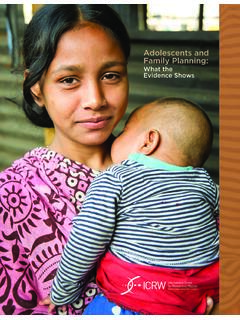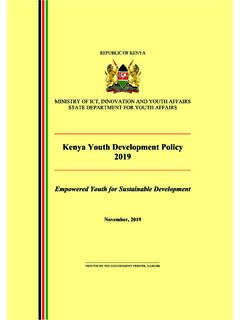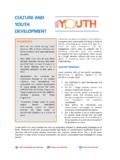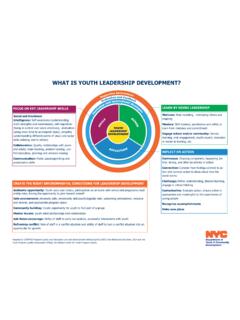Transcription of The Critical Role of Youth in Global Development
1 December 2001 Nearly half of all people in the world today are under the age of 25. Effectively addressing the special needs ofthese Youth is a Critical challenge for the future. Youth , individuals between the ages of 15 and 24, make up overone-sixth of the world s population, but are seldomrecognized as a distinct group for the important rolethey will play in shaping the than any other group, today s young womenand men will impact how people in rich and poorcountries live in the 21st century. Unfortunately,hundreds of millions of Youth especially youngwomen lack education, skills and job training,employment opportunities, and health serviceseffectively limiting their futures at a very early a result, Youth may react by unleashing risky orharmful behavior against themselves or Youth may often be perceived as contributingto society s problems, they are, in fact, importantassets for the economic, political, and social life oftheir communities.
2 Addressing key Global threats like the spread of HIV/AIDS, growing poverty, and political stability in developing countries depends onprotecting the rights of Youth and providing them with the support they need to contribute to the health andwell-being of fact sheet outlines the major challenges facing Youth and highlights policy and program recommendations inthe key issue areas of education and training, economic opportunities, and health and BriefThe Critical Role of Youth in Global DevelopmentDefining YouthThe meaning of the terms Youth , adolescents, and young people varies in different societies, asdo the different roles and responsibilities ascribed tomembers of each group.
3 In Egypt, for example, theaverage male enters the workforce at the age of 15,and in Niger about 75% of women give birth beforetheir 20th birthday. This fact sheet uses the UnitedNations definitions:!Adolescents: 10-19 years of age (earlyadolescence 10-14; late adolescence 15-19)! Youth : 15-24 years of age!Young People: 10-24 years of ageChallenges Facing YouthThe challenges facing today s Youth have atremendous impact on their quality of life. Theirreactions will affect their families and communities,and the countries and regions in which they live.
4 !The number of Youth is growing. At billion,the world today has the largest number of youthever, and this number is increasing.! Youth are poor. About 85% of the world s youthlive in poor countries.! Youth are under-educated. In the developingworld, nearly one-third of Youth are illiterate. Inthe least-developed countries, only 13% of girls and22% of boys enroll in secondary education.! Youth are unemployed. Approximately 70 millionyoung people are unemployed worldwide.! Youth are susceptible to disease.
5 Young peopleages 15-24 have the highest infection rates fromHIV/AIDS and other sexually transmitted by Age and Sex: Less and MoreDeveloped Regions, 2000 Source: United Nations Population Division, 1998 Special Challenges Facing Female YouthYoung women and girls between 15 and 24 yearsof age face special challenges in many developingcountries. As a whole, females receive lesseducation than their male counterparts, marryand become parents earlier, have fewer economicopportunities, heavy household responsibilities,and are often constrained by traditions andcustoms that do not apply to their male counter-parts.
6 It is estimated that 33-66% of sexualassaults worldwide are perpetrated against girlsage 15 or in girls has a disproportionatelypositive impact on their communities andcountries. Women with more education are morelikely to marry later and have fewer show that women s earnings are directlyinvested in the health, welfare, and education oftheir children, resulting in a long-term cycle ofpoverty reduction that spans that position female Youth to earnincome throughout their lives, including educa-tion, training, health, and family planningassistance, have a magnifying effect of helpingtheir children become healthy, educated, andproductive citizens.
7 ! Youth are sexually active. Half of all girls underage 18 are married in some countries. Further, million adolescents undergo abortions everyyear 40% of which are performed under unsafeconditions. Only 17% of sexually active Youth the majority of them married use fewer practice safe sex to protect themselvesfrom HIV s Education and Childbearing,Selected CountriesSource: Alan Guttmacher Institute, 1998.! Youth become parents. About 17 million womenages 15-19 give birth every year and have morechildren than women who start childbearing risk of birth complications is 25 times higherfor girls under age 15 and two times higher forthose between ages 15-19.
8 ! Youth are frustrated. Evidence suggests thatyouth with few economic prospects and limitedpolitical voice are more inclined to be radical,fundamentalist, revolutionary, or to abuse drugsor commit Impacts of These ChallengesMany Global problems have a particularly strongimpact on Youth . In some cases, such as the spreadof HIV/AIDS or frustration due to political disenfran-chisement, these problems have far-reaching conse-quences. Focusing on Youth will substantially boostefforts by the United States and other nations to:!
9 Stop the spread of, and heal the suffering, causedby HIV/AIDS and other infectious diseases;!Create a stable Global economic system thatequitably benefits people in all nations, both poorand rich;!Promote political stability based on participationand human rights;!Limit the number of economic and war-relatedrefugees;!Stem the tide of fundamentalism, terrorism, andhatred;!Moderate population growth;!Promote equal rights for Critical Issue Areas Facing YouthResearch by the International Center for Research onWomen (ICRW) indicates that three issue areas areespecially vital to today s Youth in developingcountries:!
10 Education and Training!Economic Opportunities!Health and SexualityHow these issues are addressed by governments indeveloping and developed countries, multilateralinstitutions like UNICEF or the World Bank,grassroots organizations, and individuals around theworld will have a tremendous impact on the future ofthe Education and TrainingAround the world, large percentages of school-agechildren are not attending school. In the least devel-oped countries, fewer than one-third of secondary-ageyouth attend school.
